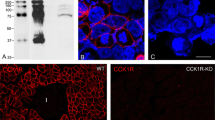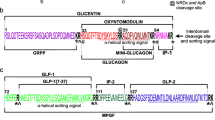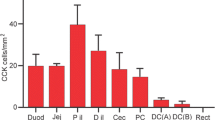Abstract
The release of secretin was studied in secretin cell-enriched preparations isolated from canine duodenal mucosa. The crude enterocytes were isolated by treating the duodenal mucosa sequentially with collagenase and ethylenediaminetetraacetic acid. Secretin cell-enriched fraction was prepared by centrifugation of the crude enterocytes in a counterflow elutriation rotor to obtain a final preparation containing 3.2±0.3 pmol/106 cell of immunoreactive secretin, which was 13-fold greater than the crude cell preparation (N=5). The cells were incubated in Hanks' balanced salt solution for 20 min at 37°C under 95% O2/5% CO2 before adding various agents and further incubated for various periods of time. The amounts of secretin released into the medium and retained by the cells were then determined by a specific radioimmunoassay. The release of immunoreactive secretin was increased dose-dependently over the control by dibutyryl cyclic-3′, 5′-adenosine monophosphate, forskolin, 4β-12-O-tetradecanoylphorbol-13-acetate, the synthetic serine protease inhibitor, camostat, and the calcium ionophore, A23187. The effects of forskolin, the phorbol ester, and A23187 were time-dependent and not observed at 4°C. The release of immunoreactive secretin was also stimulated by KCl in high concentration and by sodium oleate. The effect of A23187 was abolished in a Ca2+-free medium, while those of dibutyryl cyclic-3′, 5′-adenosine monophosphate and forskolin were potentiated by 3-isobutyl-l-methylxanthine, which did not have a significant effect when added alone. These results indicate that the release of secretin is regulated by both Ca2+- and cyclic-3′, 5′-adenosine monophosphate-dependent mechanisms. In addition, cellular protein kinase C activity may play an important role in regulation of secretion release.
Similar content being viewed by others
References
Bayliss WM, Starling EH: The mechanism of pancreatic secretion. J Physiol 28:325–353, 1902
Straus E, Yalow RS: Immunoreactive secretin in gastrointestinal mucosa of several mammalian species. Gastroenterology 75:401–404, 1978
Jorpes JE, Mutt V, Magnusson S, Steele BB: Amino acid composition andN-terminal amino acid sequence of porcine secretin. Biochem Biophys Res Commun 9:275–279, 1962
Chey WY, Kim MS, Lee KY, Chang T-M: Effect of rabbit antisecretin serum on postprandial pancreatic secretion in dogs. Gastroenterology 77:1268–1275, 1979
Chey WY, Lee YH, Hendricks JG, Rhodes RA, Tai HH: Plasma secretin concentrations in fasting and postprandial state in man. Am J Dig Dis 23:981–988, 1978
Kim MS, Lee KY, Chey WY: Plasma secretin concentration in fasting and postprandial states in dog. Am J Physiol 236:E539-E544, 1979
Tai HH, Chey WY: Rapid extraction of secretin from plasma by XAD-2 resin and its application in the radioimmunoassay of secretin. Anal Biochem 87:376–385, 1978
Schaffalitzky de Muckadell OB, Farenkrug J: Radioimmunoassay of secretin in plasma. Scand J Clin Lab Invest 37:155–162, 1977
Faichney A, Chey WY, Kim YC, Lee KY: Effect of sodium oleate on plasma secretin concentration and pancreatic secretion in dogs. Gastroenterology 81:458–462, 1981
Watanabe S, Chey WY, Lee KY, Chang T-M: Secretin is released by digestive products of fat in dogs. Gastroenterology 90:1008–1017, 1986
Otsuki M, Sakamoto C, Maeda M, Okano K, Yue H, Yamasaki T, Baba S: Effect of 1-phenyl-1-hydroxy-n-pentane on secretin release and pancreatic exocrine secretions. Jpn J Gastroenterol 75:229–236, 1978
Chey WY, Millikan L, Lee KY, Watanabe S, Shiratori K, Takeuchi T: Effect of 1-phenyl pentanol on release of secretin and exocrine pancreatic secretion in dogs and humans. Gastroenterology 84:1578–1584, 1983
Watanabe S, Chey WY, Lee KY, Chang T-M: Release of secretin by licorice extract in dogs. Pancreas 1:449–454, 1986
Shiratori K, Watanabe S, Takeuchi T: Effect of licorice extract (FM 100) on release of secretin and exocrine pancreatic secretion in humans. Pancreas 1:483–487, 1986
Watanabe S, Chang JH, Shiratori K, Moriyoshi Y, Shimizu K, Takeuchi T: Effect of a synthetic trypsin inhibitor FOY 305 (camostate) on exocrine pancreatic secretion and endogenous release of cholecystokinin and secretin in rats. Gendai Iryou 20:1058–1064, 1988
Watanabe S, Chang JH, Ishiguro H, Shiratori K, Takeuchi T: Effect of intrajejunal administration of a synthetic trypsin inhibitor FOY-305 (camostate) on exocrine pancreatic secretion and endogenous release of cholecystokinin and secretin in humans. Tan to Sui 7:1569–1575, 1986
Chang JH, Watanabe S, Shiratori K, Moryoshi Y, and Takeuchi T: Plaunotol stimulates endogenous secretin release and pancreatic exocrine pancreatic secretion in rats. Digestion 44:142–147, 1989
Shiratori K, Watanabe S, Takeuchi T, Chang JH, Moriyoshi Y: Effect of plaunotol on release of plasma secretin and pancreatic exocrine secretion in humans. Pancreas 4:323–328, 1989
Murthy SN, Lavy A, Cassey CA, Morgantini DS, Diroso VP Jr, Chang T-M: The effect of cyclic nucleotides on secretin secretion in canine duodenal mucosain vitro. Peptides 7:357–363, 1986
Murthy SN, Lavy A, Morgantini DS, Chey WY: Neurohormonal regulation of secretin secretion in canine duodenal mucosain vitro. Peptides 7(suppl 1):229–236, 1986
Murthy SN, Lavy A: Catonic environment and secretin secretion in canine duodenal mucosain vitro. Biochem Pharmacol 37:1027–1031, 1988
Li P, Lee KY, Chang T-M, Chey WY: Mechanism of acid-induced release of secretin in rats. Presence of a secretin-releasing factor. J Clin Invest 86:1474–1479, 1990
Barber DL, Walsh JH, Soll AH: Release and characterization of cholecystokinin from isolated canine jejunal cells. Gastroenterology 91:627–636, 1986
Chang T-M, Chey WY: Radioimmunoassay of secretin. A critical review and current status. Dig Dis Sci 25:529–551, 1980
Winer BJ: Statistical Principles in Experimental Design, 2nd ed. New York, McGraw-Hill, 1971
Chey WY, Escoffery R: Secretin cells in the gastrointestinal tract. Endocrinology 98:1390–1395, 1976
Sun G, Chang TM, Xue W, Wey JFY, Lee KY, Chey WY: Release of cholecystokinin and secretin by sodium oleate in the dog: Molecular form and bioactivity. Am J Physiol 262:G35-G43, 1992
Huckle WR, McArdle CA, Conn PM: Differential sensitivity of agonist- and antagonist-occupied gonadotropin-releasing hormone receptors to protein kinase C activators. A marker for receptor activation. J Biol Chem 263:3296–3302, 1988
Giraud AS, Soll AH, Cuttitta F, Walsh JH: Bombesin stimulation of gastrin release from canine gastrin cells in primary culture. Am J Physiol 253:G410-G420, 1987
Chan CB, Soll AH: Pertussis toxin-sensitive cholinergic inhibition of somatostatin release from canine D cells. Am J Physiol 255:G424-G428, 1988
Barber DL, Buchan AM, Walsh JH, Soll AH: Regulation of neurotensin release from canine enteric primary cell cultures. Am J Physiol 250:G385-G390, 1986
Barber DL, Buchan AM, Walsh JH, Soll AH: Isolated canine ileal mucosal cells in short-term culture: A model for study of neurotensin release. Am J Physiol 250:G374-G384, 1986
Buchan AM, Barber DL, Gregor M, Soll AH: Morphologic and physiologic studies of canine ileal enteroglucagon-containing cells in short-term culture. Gastroenterology 93:791–800, 1987
Barber DL, Gregor M, Soll AH: Somatostatin and muscarinic inhibition of canine enteric endocrine cells: Cellular mechanisms. Am J Physiol 253:G684-G689, 1987
Aponte GW, Taylor IL, Soll AH: Primary culture of PYY cells from canine colon. Am J Physiol 254:G829-G836, 1988
Rindi G, Grant SGN, Yiangou K, Ghatei MA, Bloom SR, Bautch VL, Soleia E, Polak JM: Development of neuroendocrine tumors in the gastrointestinal tract of transgenic mice. Am J Pathol 136:1349–1363, 1990
Madsen OD, Larsson L-I, Rehfeld JF, Schwartz TW, Leramark A, Labrecque AD, Steiner DF: Cloned cell lines from a transplantable islet cell tumor are heterogeneous and express cholecystokinin in addition to islet hormones. J Cell Biol 103:2025–2034, 1986
Aponte GW, Keddie A, Hallden G, Hess R, Link P: Polarized intestinal hybrid cell lines derived from primary culture: Establishment and characterization. Proc Natl Acad Sci USA 88:5282–5286, 1991
Shiratori K, Chen YF, Chey WY, Lee KY, Chang TM: Mechanism of increased exocrine pancreatic secretion in pancreatic juice-diverted rats. Gastroenterology 91:1171–1178, 1986
Sun G, Lee KY, Chang TM, Chey WY: Effect of pancreatic juice diversion on secretin release in rats. Gastroenterology 96:1173–1179, 1989
Lu L, Louie D, Owyang C: A cholecystokinin-releasing peptide mediates feedback regulation of pancreatic secretion. Am J Physiol 257:G430-G435, 1989
Miyasaka K, Guan D, Liddle RA, Green GM: Feedback regulation by trypsin: Evidence for intraliminal CCK-releasing peptide. Am J Physiol 257:G175-G181, 1989
Tamura Y, Hirado M, Okamura K, Minato Y, Fujii S: Synthetic inhibitors of trypsin, plasma, kallikrein, thrombin, C1 r, and C1 esterase. Biochim Biophys Acta 484:417–422, 1977
Author information
Authors and Affiliations
Rights and permissions
About this article
Cite this article
Sue, W., Chey, W.Y., Sun, Q. et al. Characterization of secretin release in secretin cell-enriched preparation isolated from canine duodenal mucosa. Digest Dis Sci 38, 344–352 (1993). https://doi.org/10.1007/BF01307554
Received:
Revised:
Accepted:
Issue Date:
DOI: https://doi.org/10.1007/BF01307554




